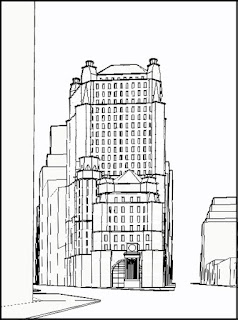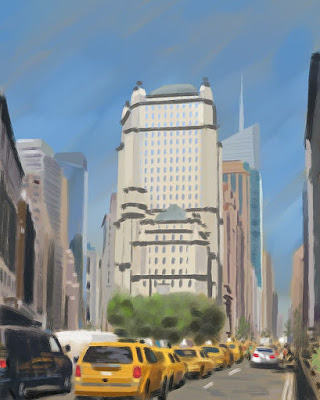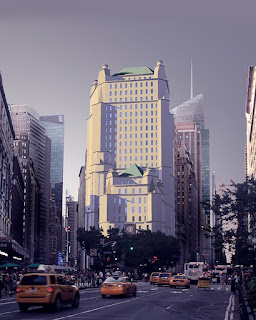The Beaux Art “palette” of stone and punched windows is an old variation on stone and glass.
In my own playing with “landmarks” along Broadway, NYC, I often used a mix of stone and glass. For my proposal on the block south of Greeley Square Park (32nd Street and Broadway) I used large areas of reflective glass set into a frame of stone.
Since the building would be “facing” north toward the adjacent park, direct sun would have little chance to show off a sculpted stone façade. See Full Length Portraits & Tall Buildings.
At the north end of the same elongated space formed by the intersection of 6th Avenue and Broadway is Herald Square, fronting on 35th Street. The square was named for the adjacent headquarters building of the New York Herald newspaper, designed by Stanford White in 1908, and demolished in 1921.
Years after painting the Greeley Block, I dropped a computer rendering of the same design onto the Herald Square site. Looking at the result made me imagine a more sculptural design along the lines of White’s eclectic 1908 style. It would give me a chance to explore a variety of light conditions via computer renderings. This was done 10 years ago, in 2011. Computer renderings were cheap and ubiquitous, but still did not have the touch of artistic magic that I have always looked for.
I modeled the idea in AutoCAD and established views from the south, as seen in the wireframes above.
Then, for the fun of it, rendered it in Accurender and pasted it into a photo of the site in Photoshop.
______________________________________________________________________________
So now that we have a design and a site, let me bring on the “Light Taxonomy” from my previous post. I will not use Spot Lighting or Confetti Lighting, as they are more specialized than I want here.
1. Beaux Art
2. Frontal
3. Dusk
4. Saarinen
5. Ambient
6. Ferriss
I now spent numerous photo sessions in Herald Square shooting the site under different light/atmosphere conditions and different times of the day. I eventually had reasonable photos of the site under all 6 light conditions.
Next, I created 6 renderings of the computer model from the same viewpoint, each differing only by the light type and corresponding atmosphere. Each rendering (via Accurender) took into account light angle, time of day, sky, sun and context color, reflected view, etc.
Using Photoshop I pasted the building rendering into the corresponding photo, setting it behind the trees in the square itself.
Finally, I rendered (on my computer tablet) the final Photoshop’d image to make it more unified in terms of value, color and composition. If I was actually producing a finished rendering, I would take this “sketch” rendering as the general goal for the final image.
Below you will find each view’s light direction, rendered building, site paste-up and “sketch” rendering.
FERRISS
However, I hope the reader gets some ideas and inspiration from the exercise.
Addendum: the idea for a light taxonomy came from John Hedgecoe's The Photographer's Handbook, 2nd Ed. The 8 photos taken from dawn to dusk show an amazing range of color and light.





































Apeiro building, located close to Niagara Falls, provides excellent building services and dependable, knowledgeable builders to help you create the house of your dreams.
ReplyDeleteNiagara Falls home builders near me